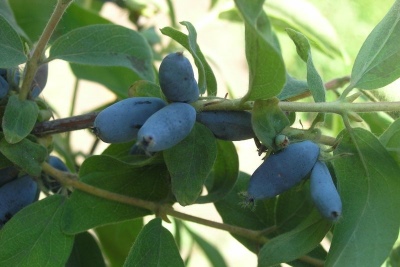
- Authors: Skvortsov Alexey Konstantinovich, Kuklina Alla Georgievna (Main Botanical Garden of the Russian Academy of Sciences named after N.V. Tsitsin)
- Year of approval: 1998
- Growth type: vigorous
- Description of the bush: medium spreading
- Bush height, m: 2
- Escapes: medium in length, pubescent, curved, light brown
- Leaves: medium, green, strongly pubescent, matte
- Crown: rounded
- Flowers: slightly yellow
- Fruit size: large
Edible honeysuckle has become incredibly popular in recent years. This is due to the fact that the berry is very useful, is widely used in cooking, and is also endowed with simple agricultural techniques. Popular varieties include the titmouse honeysuckle of Russian selection.
Breeding history
Titmouse is a berry culture that got life within the walls of the Main Botanical Garden of the capital in 1985. The authors of the variety are breeders A.K.Skvortsov and A.G. Kuklina. When creating the variety, several varieties of honeysuckle from the Magadan region and Kamchatka were used. Titmouse has been listed in the State Register of Breeding Achievements since 1998. Early maturing honeysuckle can grow and bear fruit in almost any region.
Description of the variety
This variety is a vigorous shrub with a rounded crown with medium spreading branches. In the first few years, the bush grows slowly, but by the age of seven it grows up to 2 meters in height. Honeysuckle is characterized by moderate foliage, green leaves with a pronounced edge and curved shoots of a light brown color. A feature of the species is considered to be massive peeling (peeling) of the bark of three-year-old shrubs.
The flowering period for the shrub begins at the end of April, in the first days of May. At this time, the shrub is abundantly strewn with pale yellow or white-cream medium-sized flowers, collected in small inflorescences. The persistent scent of flowers attracts bees, flies and bumblebees.
Fruit characteristics
Titmouse is a large-fruited variety. Fruits weighing 0.8-1.3 grams ripen on mature bushes. The berries have an elongated-oval shape, sometimes elliptical with a pronounced tuberosity of the surface. At the stage of technical ripeness, the berries are colored in a yellowish-gray color, and fully ripe honeysuckle becomes almost black with a characteristic bluish bloom. The peel of the berries is thin, elastic.
Berries have a universal purpose - they are very tasty, so they are eaten fresh. In addition, delicious jam, fruit drink, preserves are obtained from the berries. Due to the fact that the variety is early maturing, the berries are very tender and sensitive to transportation. It is also worth noting that honeysuckle is not stored for a long time.
Taste qualities
This species is famous for its excellent taste. The pulp of the fruit is tender, fleshy, very juicy. The taste is dominated by light sweetness, perfectly combined with refreshing sourness. The aroma of the fruit is pleasant, but not very bright. Berry pulp contains more than 7% sugars and 2.2% acids.
Ripening and fruiting
Titmouse is a bright representative of early maturing varieties. The shrub begins to bear fruit in the 3rd year after planting. The fruits ripen unevenly, quickly weathered, become soft, so it is recommended to remove them immediately. You can taste the first harvest closer to mid-June. Mass ripening occurs after June 15-17.
Yield
Titmouse brings good harvests. Providing the correct care for the honeysuckle, an average of 4.3 kg of useful berries can be removed from one bush. The maximum yield is 7 kg of fruit.

Self-fertility and the need for pollinators
Self-pollination of the variety is low. A good harvest is possible only when donor varieties are planted nearby. The following types of honeysuckle are effective pollinators: Fortuna, Kamchadalka and Malvina.
Growing and care
Planting honeysuckle is best done in early autumn (September). You need to buy two / three-year-old seedlings with a branched rhizome. It is better to arrange seedlings at a distance of 2 meters so that there is no shade.
The plant does not need intensive agricultural technology, but watering, fertilizing, crown formation and pruning of dry branches is necessary. In addition, weeding and loosening of the soil are important, as well as the prevention of diseases.


Disease and pest resistance
Despite good immunity, Titmouse can be exposed to powdery mildew and some phytoviruses. Among the pests that attack honeysuckle bushes, the most annoying are: aphids, fingerwing and honeysuckle mites.

Winter hardiness and the need for shelter
The titmouse has high frost resistance. The shrub can easily withstand frosts down to -30 degrees, and the flowers tolerate recurrent spring frosts. By winter, the shoots of the bush are tightly tied and wrapped in burlap.
Location and soil requirements
Berry culture is thermophilic, loves light, sun, air. The shrub grows comfortably in loose, fertile, breathable, moisture-permeable soils with neutral acidity. The most favorable will be loamy soil with deep groundwater.
































































